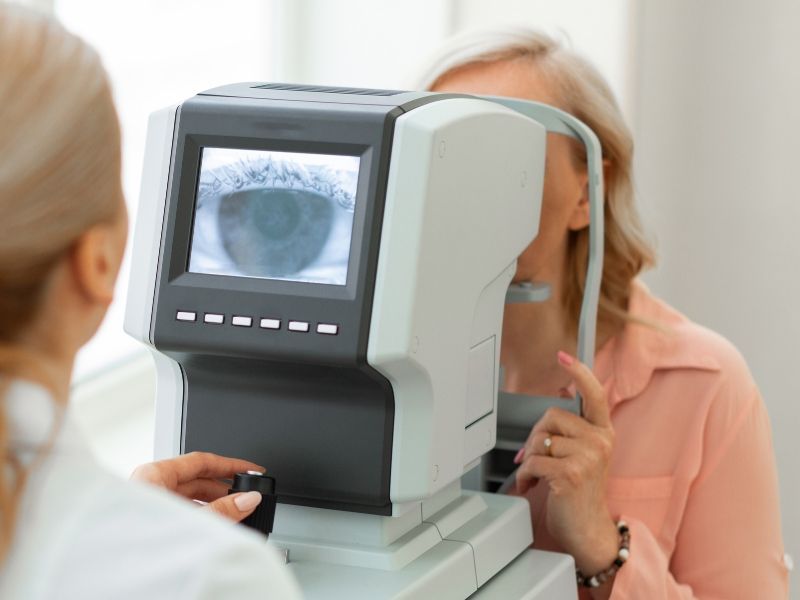Eye care. Health care. You probably think of them as separate, and that’s fine, right? You know that one place will focus on your eyes, and the other will pretty much take care of the rest.
But if you have blurred vision from a retinal condition, you find out how a health problem can risk your vision, too.
Ophthalmologist Kimberly Tran, M.D., specializes in retinal diseases such as macular degeneration, diabetic retinopathy, retinal vein occlusion and retinal detachment.
Dr. Tran is based at an eye care center — Sanford Eye Center & Optical in Sioux Falls, South Dakota. Yet she operates at the nearby hospital and collaborates with patients’ primary care and specialty doctors as well as other eye care providers to play a crucial role in her patients’ vision and health care team.
“When I meet with my patients for the first time, I like to tell them, ‘This is the beginning of a relationship.’ That’s one of the parts I love best about my job — forming a long-term relationship with my patients,” said Dr. Tran, who recently joined Sanford Health to build those new relationships.
The retina’s role
Dr. Tran describes the retina as “a very thin layer of nerve cells that wrap along the inside of the eye. These cells sense light and send signals to the brain, allowing you to see.” Problems with the retina will cause blurred vision, and if not appropriately treated, the vision loss can be permanent. That’s where Dr. Tran steps in.
Take, for example, a patient with poorly controlled diabetes. “Poorly controlled diabetes can cause swelling, bleeding, or scarring and retinal detachment in the retina. Without treatment, this can lead to permanent vision loss,” Dr. Tran said.
In patients with age-related macular degeneration, some qualify for injections that help to preserve their vision over time. “This can mean many extra years of useful vision for our patients,” Dr. Tran said.
You’d want a specialist for this kind of surgery

If a patient has a retinal detachment, when the retina pulls away from the inside wall of the eye, Dr. Tran can perform surgery to repair it.
However, it’s an exacting surgery involving a microscope and tiny instruments that actually enter the eyeball. In other words, not just anyone can do it. After college, it still requires four more years of medical school, a one-year internship, three years of ophthalmology residency, and an additional one to two years of surgical retinal fellowship to learn specifically how to treat retina issues and operate on the retina.
So Dr. Tran, who did her residency and fellowship at Bascom Palmer Eye Institute in Miami, ranked the No. 1 eye hospital by U.S. News & World Report, spent as long in higher education and training as it takes for a newborn to reach the teen years.
She then spent an additional year at Bascom Palmer Eye Institute as chief resident, clinical instructor and co-director of the ocular trauma service.
Treating patients of all ages
Conditions such as diabetes and high blood pressure, as well as age-related macular degeneration and retinal detachment, may bring patients routinely to a specialist like Dr. Tran. But she also treats patients of all ages. Some may have inherited retinal diseases, inflammation, infection or injuries to the eyes, all of which could cause problems in the retina and blurred vision and need urgent treatment.
It’s easy for her to communicate with patients’ Sanford Health doctors to help them get the best outcome in every area of their health.
“It’s important to have a retina specialist within the Sanford system because these patients with diabetes, high blood pressure, even rheumatologic disease, can all have vision-threatening complications from their disease that may require a retina specialist,” Dr. Tran said. “I think it’s important as part of a comprehensive health care plan to have all of these subspecialists available to our patients.”
‘Exciting time in retina’
Dr. Tran loves working in her specialty. “It’s a really exciting time in retina,” she said. New methods of imaging can better examine the retina, plus gene therapy is on the horizon for kids with inherited diseases, and new medications can help manage other diseases better than before.
And then there are her patients. “Just like no two people are the same, no two retinas are the same. I really enjoy that diversity in my patients and tailoring my treatment to their individual needs,” Dr. Tran said.
“You get to be a part of their family,” she added. “Grandparents will bring in pictures of their kid, and we’ll start the visit with, ‘OK, show me an updated picture.’ Some of my younger kids that I’ve treated, you see them go through school. You see them go off to college.”
Who to see for eye care
Providers working in Sanford Health eye clinics include ophthalmologists and optometrists. Here’s a brief look at what people in those different roles do.
Ophthalmologists
Sanford Health’s ophthalmology physicians, who go to medical school and then an ophthalmology residency, diagnose and treat disorders and diseases of the eye.
An ophthalmologist specializes in diagnosis and treatment of refractive, medical and surgical problems related to eye diseases and disorders.
Ophthalmologists provide a wide range of eye-related services from comprehensive eye exams to performing eye surgery. At Sanford Health, ophthalmology subspecialties in addition to retina include pediatric ophthalmology surgery, sutureless cataract surgery, laser surgery and plastic surgery.
Optometrists
Sanford Health’s optometrists attend optometry school for four years. They provide general eye care for children through seniors, including primary vision care ranging from routine eye exams to the diagnosis, treatment and management of changes in vision. This may include prescribing corrective lenses, detecting vision abnormalities or prescribing medications for ocular diseases.
Optometrists have various specialties including family and pediatric vision care, treatment and management of diseases, vision loss due to head trauma and brain injuries, as well as vision therapy for children and adults.
An optometrist can refer patients to Sanford Health ophthalmologists or other specialists for further evaluation and treatment if diseases are suspected or discovered.
More stories
- Life in focus: LASIK now available at Sanford Health
- Seeing through eye disease
- An optometrist can help spot health issues
…
Posted In Children's, Eye Care, Senior Services, Specialty Care
